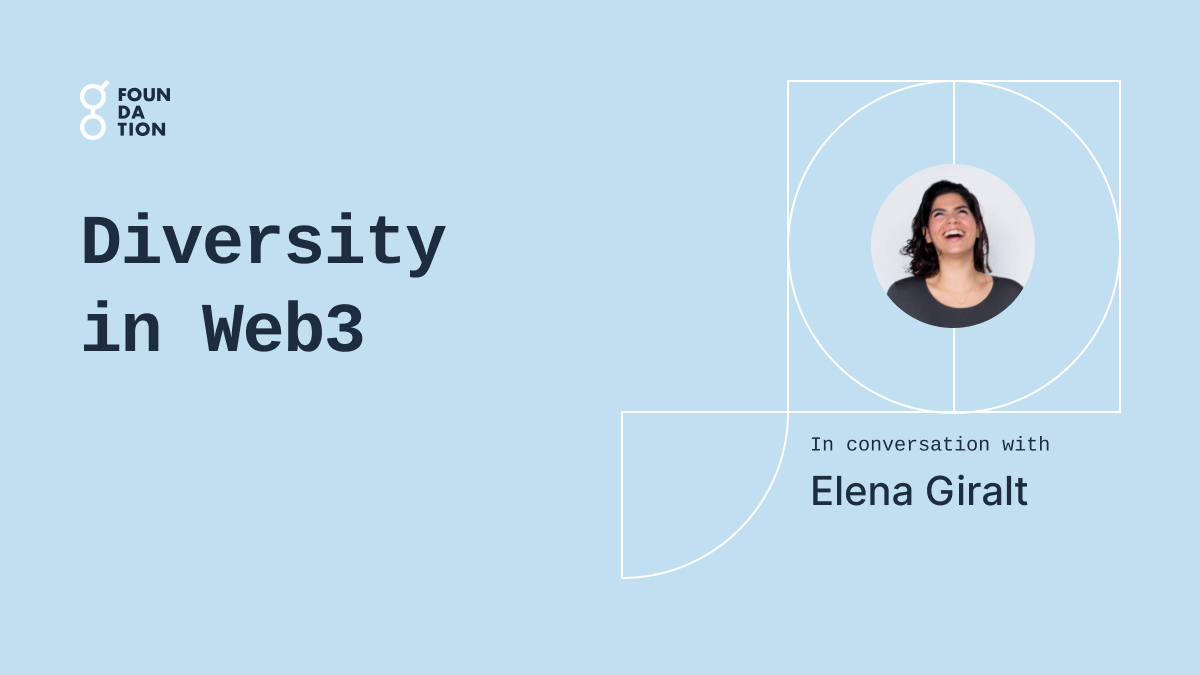On diversity in web3 - in conversation with Elena Giralt
Hi! Recently we had the opportunity to talk with Elena Giralt, who specializes in cryptocurrencies, blockchain, decentralized media and technology. She organizes workshops and meetups, like the Blockchain Latinx Meetup. She’s currently working in product marketing at Hiro Systems, a developer tools company for Stacks. We spoke about diversity in web3, if it means the same as being inclusive, and how we can make people feel more welcome in the space.

Would you say today’s web3 space is diverse?
Not to dodge the question, but I think it’s difficult to generalize. There are certain properties that are binary - a lamp is either on or off, a ball is either still or in motion. Other properties exist along a spectrum. An industry like web3 certainly has pockets that are inclusive of many perspectives, where diverse backgrounds and experiences are represented. It also has pockets that are homogenous and siloed. Diversity is not a static state and for the most part, it doesn’t happen by accident. Take something like security- maintaining a network secure is a group effort. No one in web3 would propose that a single group is responsible for the security and resilience of a network. Diversity is similar. In order to have a community where different perspectives are welcome and valued, the members of that community need to agree collectively on community standards and social norms that foster that type of environment.
All that said, my experience in web3 has been incredibly diverse and enriching. I’ve learned about economics, game theory, zero-knowledge proof cryptography, political activism, finance from so many people - most of whom have perspectives and opinions very different from my own.
Why is diversity so important when building new things?
It depends on what you’re trying to build. If you are trying to build widgets, gears, or anything standardized - you probably don’t need that much diversity. However, most people don’t find that work particularly stimulating or meaningful. If you are trying to build a vibrant, resilient network where new ideas lead to collaboration, iteration and exponential progress, then diversity is paramount. The key word here is “new.” If you are trying to build something radically new, it’s hard to do that when everyone is making the same assumptions, based on the same experiences and the same constraints.
I should say here, “diversity” is often used as a blanket term for several concepts and it’s worth being precise lest people shrug off the topic entirely.
Diversity - when there is a variety of ethnic backgrounds, socioeconomic groups, genders, sexual orientations, physical conditions, etc represented in a group.
Inclusion - when all perspectives are valued and weighted equally, particularly when it comes to decision making.
Equity - in this context, equity refers to fairness, specifically processes and accommodations that ensure different people have the same access to participating in the group. This one is the trickiest I think to define and maintain. For example, let’s think about blind and vision impaired people. How many web3 or digital-first communities are inclusive of these groups? Many people might say, “we totally welcome people from this group.” Equity refers to the process of actually making sure that blind and visually impaired members can participate meaningfully. Good Vibes - generally, a community that is fun to be a part of!
So you can have a community that is diverse but not inclusive. Similarly, you can have a fun community that is pretty homogenous. I think the most important thing to keep in mind here is that these definitions depend very much on what context you’re in. “Diversity” in Boise, Idaho might look very different than “diversity” in Marseilles, France.
There are so many women, genderqueer folks in the space doing great things but I can’t help feeling you really need to want to find them in order to do so. How do we get more exposure to those underrepresented groups?
I’ve seen several approaches. Some people don’t want to be defined solely by their identity. Other people love building community around a common thread like identity or language. So every time I see a twitter thread of women in web3 or Latinos in tech, I also see pushback and I think that’s a good thing!
As you point out, there are many exciting projects led by people who don’t fit a classic tech startup founder stereotype. To be honest, I’m not really sure what the best way to increase exposure for these projects other than asking each founder how they want to be represented.
How can we make people feel more welcome and comfortable in the space?
Community standards and shared rituals go a long way! I think there’s a difference between signing a code of conduct when you first enter a Discord server and seeing those values come to life in the interactions of a groups members. Some communities are very good at fostering an environment that is both welcoming and fun. The NFT project CryptoCoven has done this exceptionally well. The biggest thing to keep in mind is that this isn’t easy and it isn’t one person’s responsibility.